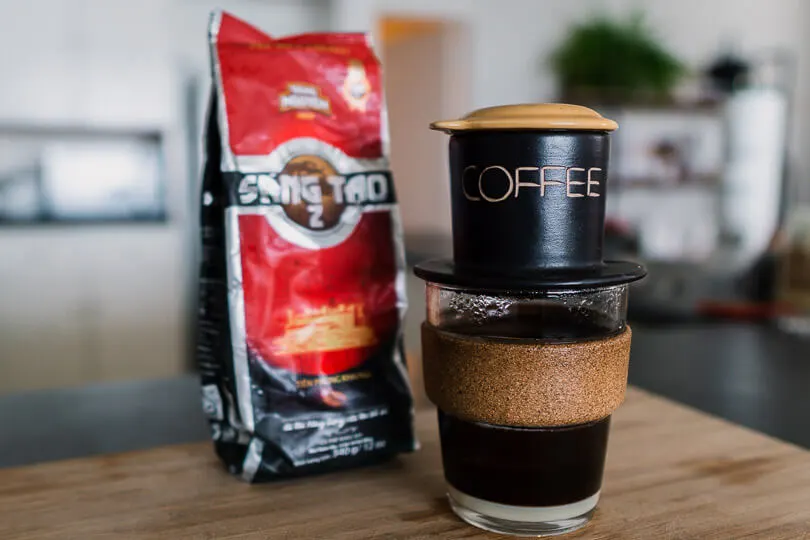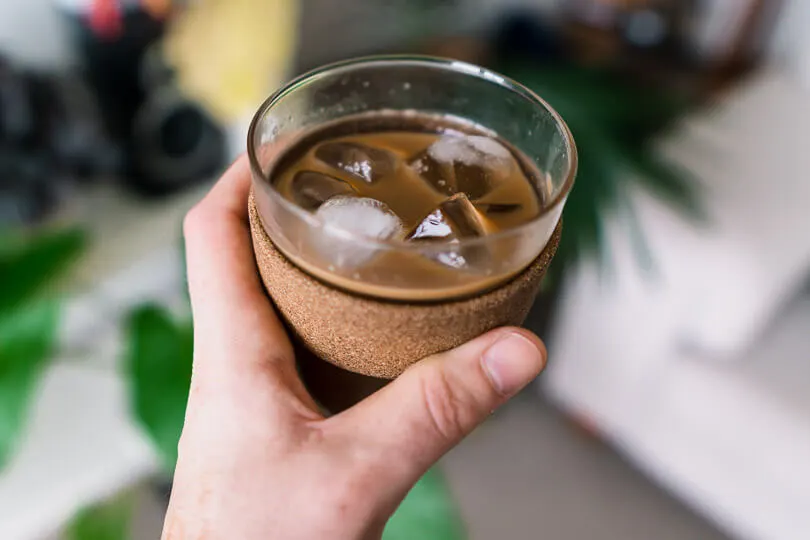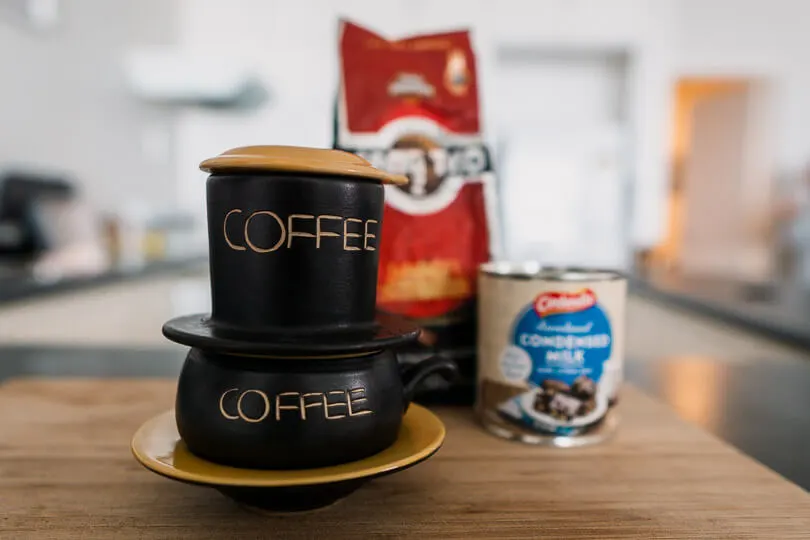I’ll admit it – I’m a coffee snob. If you drink copious amounts of coffee every day, then it makes sense to brew the best cup possible, right?
The first time I ever had Vietnamese coffee was shortly after arriving in Ho Chi Minh City – post-14 hour long haul flight. It was hot. Our hostel had a cafe downstairs so we ordered a ca phe sua dua (no, we definitely didn’t use the correct pronunciation), aka Vietnamese iced coffee.
For starters, our coffees were 20,000 VND each. That’s less than $1 USD. At that price, we would have been lucky to get instant back home.
It took a few minutes and our Vietnamese iced coffees were brought out. By this point, our expectations diminished. We just needed coffee. We later found out they prepare the coffee in advance as Vietnamese coffee lasts longer than Arabica bean coffee.
So we were delighted to find our coffees tasted something like a caramel frappuccino from Starbucks. Cold & refreshing, a huge caffeine hit, and deliciously sweet.
What is Vietnamese Coffee?
Everyone has heard of coffee from Africa and South America. However, you might be surprised to learn that Vietnam is the second largest producer of Coffee in the world – after Brazil.
What’s especially unique about this is the type of coffee beans grown in Vietnam. Instead of the commonly grown Arabica bean, Vietnam predominantly grows Robusta beans.
These beans are generally considered to be of a lower quality, possessing much less desirable traits than the more expensive Arabica beans.
However, this didn’t stop the Vietnamese from drinking coffee. Instead, they innovated how coffee should be brewed.
By creating a slow, drip brewed coffee and combining the Vietnamese coffee with condensed milk, the Vietnamese have created a delicious style of coffee not commonly found in the Western world.

Best Vietnamese Coffee Beans
Vietnamese coffee should be made with Robusta beans. These beans are easier and cheaper to grow than Arabica beans. Robusta beans tend to be more bitter, less acidic and contain almost twice as much caffeine.
There’s nothing stopping you from brewing your Vietnamese coffee with freshly ground Arabica beans, bear in mind that it will taste very different to what is typically sold in Vietnam.
If you want the absolute best coffee possible, you should consider grinding your robusta beans fresh each time you brew a cup. A medium grind would be best to ensure the grinds don’t fall through the holes, but also compact enough to prevent water draining straight through.
To make things easier, we choose not to grind our own Robusta beans. Unlike Arabica beans, your coffee will still turn out amazing if you purchase pre-ground coffee beans. This is much easier and will ensure you achieve a consistent brew each time, so we recommend buying your beans already ground.
Your pre-ground beans will stay fresh for longer than a year as long as it has been vacuum sealed. Once open, it will maintain it’s flavour for at least 3 months.
Now, any Robusta coffee bean will do the trick. But we feel that if you want to make a Vietnamese coffee, then you should use Vietnamese coffee.
Our number one pick is Sang Tao 2 from Trung Nguyen. If you are in Vietnam, then these cafes are everywhere and you will easily find one. If you are based outside of Vietnam, you can easily and affordably purchase Trung Nguyen coffee from Amazon. This is one of our top things to buy when we visit Vietnam.
A quick disclaimer: we recommend avoiding most Vietnamese coffee brands sold by vendors in markets around Vietnam, including Ben Thanh Market in Ho Chi Minh City. They often will not be anywhere near as fresh as a reputable cafe.
They will ask you to smell the beans to check that they are good, but the smell is not a suitable indicator of coffee beans’ freshness. You need to taste coffee to determine how fresh it is. On top of this, they will surely do their best to rip you off.
Another popular choice for Vietnamese coffee is a French blend called Cafe Du Mond. It’s not made in Vietnam, but it is made with Robusta beans so it should be very similar.

Follow us on Instagram!
Vietnamese Coffee Filter
Traditionally, Vietnamese coffee is brewed inside a phin filter. They are simple ceramic or stainless steel coffee filters with holes punched out of the bottom.
Any drip coffee filter will work for brewing a Vietnamese coffee. If you already have a high-quality drip filter, such as a Hario V60 or Kalita Wave, then you can just use this.
If you are looking to purchase one specifically for Vietnamese coffee, then look out for something affordable. Metal is most commonly used, but we have a ceramic one that looks a bit nicer and works fine.
You can find this filter at any market in Vietnam for a few dollars. There’s no need to overthink it as any phin filter will work.
If you aren’t in Vietnam, this Premium Vietnamese Coffee Filter is cheap and perfect:
Condensed Milk in Vietnamese Coffee
Robusta beans are notoriously strong and bitter. These qualities are why most Westerners prefer Arabica coffee beans.
The Vietnamese worked out that by adding a generous helping of condensed milk to their coffees, they could counteract this.
If you are counting your calories you can, by all means, skip the condensed milk. But we would also suggest that Vietnamese coffee may not be the best choice for you, as it is the condensed milk that makes it so delicious.
Condensed milk is usually sold in a can. Any brand will work fine, just make sure you don’t by a different product instead. Evaporated milk is NOT a substitute.

Vietnamese Coffee Recipe
Once you have attained the beans, condensed milk and a phin filter, making Vietnamese coffee is actually very simple.
Ingredients
- 1 Heaped tbsp Trung Nguyen ground Robusta coffee beans
- 1 tbsp sweetened condensed milk
- Nearly boiling water
- Rinse your glass and phin filter with boiling water.
- Pour 1 tablespoon of condensed milk into your glass. Adjust the amount of condensed milk to taste with your next cup of Vietnamese coffee.
- With your filter on a chopping board or bench, add 1 heaped tablespoon of medium to coarse ground Robusta coffee beans to your phin filter
- Give the filter a slight shake to ensure the beans are distributed evenly – they should form an even, flat surface.
- Gently place the inside part of the phin filter on top of the coffee grounds. The key word here is gently – you don’t want to compress the beans as this will compact them and result in a bitter, over-extracted brew. You can twist the inside part slightly to even out the grounds, but don’t press down.
- Place your phin filter on top of your glass. By not putting the filter on your glass until this stage, you reduce the amount of coffee grinds that fall into your glass.
- Slowly pour just enough boiling water into your filter until you can barely see the water. This is called the bloom, which allows all the coffee grounds to be evenly saturated with water.
- Wait about 20 seconds, then fill the phin filter with boiling water to the top and cover with the lid.
- Now, wait until all the water has dripped through the filter into the cup. This should take about 3 minutes.
- Remove the phin filter and stir your condensed milk into your coffee. If you are making Vietnamese iced coffee (ca phe sua dua), then quickly fill your glass to the top with ice cubes. Be generous with the ice – the more ice you add, the less diluted your drink will be.


Thanks for the share, esp how to brew your own VN coffee at home. Real and easy steps to every word.
I first tried an original in Saigon recently and now I don’t look for others.